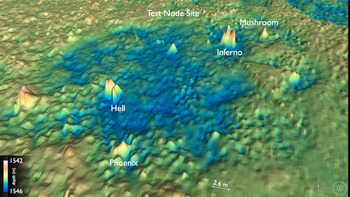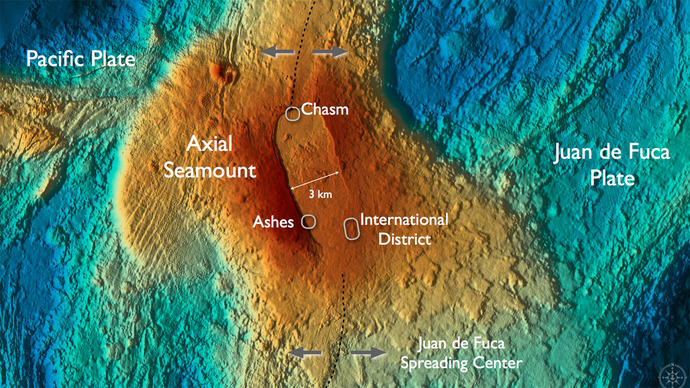
This bathymetric map of ASHES Hydrothermal Field shows the location of many of the black smoker chimneys that dot this site. The chimney Inferno rises 4 m (~ 12 feet) above the surrounding seafloor and is ~ 11 meters from its neighbor called Mushroom. Colleagues from NOAA-PMEL have worked at this site for two decades, monitoring changes in the chimneys and fluid chemistry.
It is 1815 (6:15 pm Pacific Daylight Time) and we are about to go into the water with the robotic vehicle ROPOS again to dive in the ASHES hydrothermal field at a water depth of over 4500 feet. The vent field is an important instrumentation site for NSF’s cabled observatory because it hosts several active black smoker chimneys and numerous sites of diffuse flow. The chimneys are composed of metals rich in sulfur, zinc, lead, iron and copper. They form when the superheated (700°F) hydrothermal fluids mix vigorously with the near-freezing seawater. The black plumes are fine-grained metal sulfides that crystallize during mixing. During the dive we will intensely image several of the chimneys and the abundant animals and microorganisms that grow on the outside of the chimneys. We will see vibrant tubeworms with bright red plumes sticking out from white tubes, brown-red palm and sulfide worms, perhaps blue ciliates, and numerous spider crabs. We will also deploy some novel chemical sensors for testing and will recover a test node that was deployed last year.
The hydrothermal vents are of intense interest because they are one of the most extreme environments on earth, hosting single-celled organisms that can thrive at temperatures of 250°F! These hyperthermophiles live in the absence of sunlight and obtain their energy and cell building materials from volcanic gases such as carbon dioxide, hydrogen sulfide, and hydrogen. At Axial, we are very interested in better understanding how volcanoes support this life, the relationship of seismic activity within the volcano and melt migration, emission of volcanic gases and hydrothermal fluids, and how the biological communities are impacted by volcanic events. Having the power and bandwidth supplied by the cable at this site will let us deploy mass spectrometers, fluid and microbial DNA samplers, chemical sensors, seismometers, and pressure-tilt meters. The last two of these sensors are critical in helping us predict when an eruption might occur or is occurring. If these sensors had been on the seafloor in April of this year, we would have known in real time that the volcano was erupting and how long the eruption lasted. We are anxious to get the sensors deployed in 2013 to “listen to the heartbeat of the volcano”.


